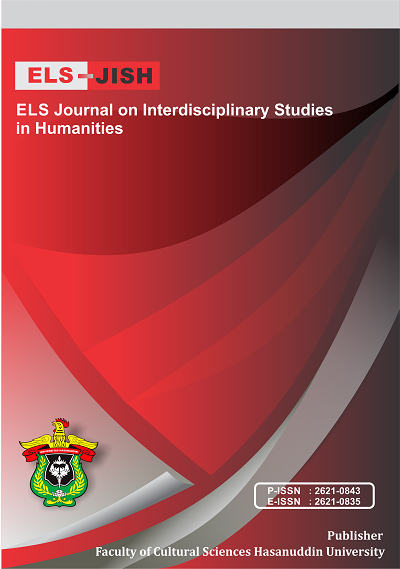Boosting ESL Vocabulary: The Role of Interactive Method in Language Acquisition
DOI:
https://doi.org/10.34050/elsjish.v7i3.36648Keywords:
ESL, Interactive Method, Vocabulary Enhancement, Vocabulary AcquisitionAbstract
This study investigated the effectiveness of interactive methods in enhancing vocabulary acquisition among English as a Second Language (ESL) students. Focusing on innovative teaching strategies, the research examined how interactive activities such as games, role-playing, and technology-assisted learning affect vocabulary retention and use. The research question is "What is the impact of the interactive method on the students' vocabulary enhancement?" There were 100 students of Marine Cruise Yogyakarta, Sukoharjo Branch, who were selected for this research. The data collection method was mixed method through open-ended questionnaire, observation, and interview. Descriptive narrative research design was used to analyze the data through triangulation. The result showed that interactive method significantly contribute to vocabulary enhancement in learning English as a Second Language (ESL) especialy in; 1) student engagement, 2) integration of technology, 3) collaborative learning. This research provides valuable insights for educators seeking to implement effective strategies for teaching vocabulary in ESL classrooms.Downloads
References
Alakrash, H. (2020). The role of digital tools in interactive language learning: A review of recent studies. Journal of Educational Technology and Society, 23(4), 123-136.
Alfadil, M. (2020). Personalized learning and adaptive technologies in language acquisition: A cognitive perspective. Journal of Learning and Instruction, 58, 45-60.
Al-Mubireek, S. (2021). Interactive methods for enhancing vocabulary acquisition in ESL learners: Insights from a case study. TESOL Journal, 12(3), 234-248.
Amelia J, Y., Wen Bin, W., & Fathu Rahman, F. (2024). Vocabulary Mastering of Hanyu Shuiping Kaoshi Level 3 Students of Chinese Language and Culture Study Program Hasanuddin University. ELS Journal on Interdisciplinary Studies in Humanities, 7(3), 410-417. https://doi.org/10.34050/elsjish.v7i3.37181
Astriningsih, A., & Mbato, C. (2019). Enhancing vocabulary learning through collaborative projects in an Indonesian context. Journal of Language and Education, 4(1), 54-67.
Chen, X., Wu, Z., & Zhang, Y. (2022). Digital games in language education: A meta-analysis. Journal of Educational Research and Development, 15(2), 78-93.
Creswell, J. W. (2013). Research design: Qualitative, quantitative, and mixed methods approaches (4th ed.). Sage Publications.
Flanagan, J. C. (1954). The critical incident technique. Psychological Bulletin, 51(4), 327-358.
Gay, L. R., & Mills, G. E. (2012). Educational research: Competencies for analysis and applications (10th ed.). Pearson.
Ghalebi, R., Alavi, S., & Moinzadeh, A. (2020). The impact of collaborative vocabulary learning on language acquisition. Language Learning & Technology, 24(3), 1-17.
Gumartifa, I., Rohim, A., & Syamsuddin, R. (2023). Active learning strategies in promoting vocabulary acquisition: An ESL classroom study. International Journal of Language Education, 5(2), 44-59.
Huang, J., Wang, Z., & Li, S. (2021). Traditional versus interactive methods in ESL teaching: A comparative study in China. Journal of Language Teaching Research, 14(1), 89-103.
Jeyaraj, J. (2019). The effectiveness of interactive games in vocabulary teaching: A case study in Malaysia. Journal of Educational Technology, 32(1), 67-80.
Limeranto, A., & Bram, R. (2022). Integrating interactive methods and traditional instruction in ESL vocabulary learning. Journal of English Language Studies, 12(2), 101-116.
Malikovna, M., Beknazarova, L., & Karimova, S. (2022). A comparative study of traditional and modern methods in ESL vocabulary teaching. Language and Learning Journal, 10(4), 92-108.
Miles, M. B., & Huberman, A. M. (1994). Qualitative data analysis: An expanded sourcebook (2nd ed.). Sage Publications.
Moreno, R., & Mayer, R. E. (2007). Interactive teaching tools: Promoting active engagement in language learning. Educational Psychology Review, 19(3), 309-326.
Munna, A. S., & Kalam, M. A. (2021). Pedagogical frameworks for interactive language learning: A comprehensive review. International Journal of Language Pedagogy, 4(3), 98-114.
Rahman, F. (2018). The constraints of foreign learners in reading English literary works: A case study at Hasanuddin University. Journal of Arts and Humanities, 7(2), 01-12.
Rahman, F., Abbas, A., Hasyim, M., Rahman, F., Abbas, A., & Hasyim, M. (2019). Facebook group as media of learning writing in ESP context: A case study at Hasanuddin University. Asian EFL Journal Research Articles, 26(6.1), 153-167.
Samaddar, A., & Sikdar, P. (2023). The impact of student participation in interactive ESL classes. Language Learning Research Quarterly, 7(1), 13-29.
Sugiyono. (2017). Metode penelitian kuantitatif, kualitatif, dan R&D. Alfabeta.
Vygotsky, L. S. (2011). Mind in society: The development of higher psychological processes. Harvard University Press.
Yaumi, M. T. A. H., Rahman, F., & Sahib, H. (2023). Exploring WhatsApp as Teaching and Learning Activities during Covid-19/New Normal era: A Semiotic Technology Analysis. International Journal of Current Science Research and Review, 6(12), 7627-7634.
Yaumi, M. T. A. H., Rahman, F., & Sahib, H. (2024). Bridging Language and Technology through Semiotic Technology. International Journal of Social Science Research and Review, 7(1), 52-61.
Yu, H., Zhang, W., & Yang, L. (2022). Interactive methods in ESL classrooms: Bridging theory and practice. Journal of Language Teaching & Research, 13(1), 91-103.
Zhang, Y., & Li, H. (2020). Cognitive engagement and interactive methods in vocabulary learning. Educational Psychology, 35(2), 189-205.
Downloads
Published
How to Cite
Issue
Section
License
Copyright (c) 2024 Yuli Ari Sandy, Barli Bram

This work is licensed under a Creative Commons Attribution-ShareAlike 4.0 International License.

















